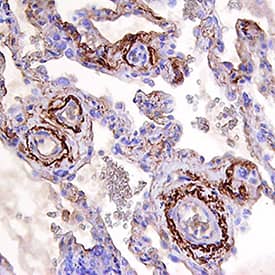Human BMP-6 Antibody
R&D Systems, part of Bio-Techne | Catalog # AF507


Key Product Details
Species Reactivity
Validated:
Cited:
Applications
Validated:
Cited:
Label
Antibody Source
Product Specifications
Immunogen
Gln382-His513
Accession # P22004
Specificity
Clonality
Host
Isotype
Endotoxin Level
Scientific Data Images for Human BMP-6 Antibody
BMP‑6 in Human Lung.
BMP-6 was detected in immersion fixed paraffin-embedded sections of human lung using Goat Anti-Human BMP-6 Antigen Affinity-purified Polyclonal Antibody (Catalog # AF507) at 15 µg/mL overnight at 4 °C. Tissue was stained using the Anti-Goat HRP-DAB Cell & Tissue Staining Kit (brown; Catalog # CTS008) and counterstained with hematoxylin (blue). Specific staining was localized to smooth muscle in vasculature. View our protocol for Chromogenic IHC Staining of Paraffin-embedded Tissue Sections.Alkaline Phosphatase Production Induced by BMP‑6 and Neutralization by Human BMP‑6 Antibody.
Recombinant Human BMP-6 (Catalog # 507-BP) induces alkaline phosphatase production in the ATDC5 mouse chondrogenic cell line in a dose-dependent manner (orange line). Alkaline phosphatase production elicited by Recombinant Human BMP-6 (0.15 µg/mL) is neutralized (green line) by increasing concentrations of Goat Anti-Human BMP-6 Antigen Affinity-purified Polyclonal Antibody (Catalog # AF507). The ND50 is typically 0.75-3.75 µg/ml in the presence of L-ascorbic acide (50 µg/mL).Applications for Human BMP-6 Antibody
Immunohistochemistry
Sample: Immersion fixed paraffin-embedded sections of human lung
Western Blot
Sample: Recombinant Human BMP-6 (Catalog # 507-BP)
Neutralization
Formulation, Preparation, and Storage
Purification
Reconstitution
Formulation
Shipping
Stability & Storage
- 12 months from date of receipt, -20 to -70 °C as supplied.
- 1 month, 2 to 8 °C under sterile conditions after reconstitution.
- 6 months, -20 to -70 °C under sterile conditions after reconstitution.
Background: BMP-6
Human BMP-6 is one of at least 15 structurally and functionally related BMPs, which are members of the transforming growth factor beta (TGF-beta) superfamily. BMPs were originally identified as protein regulators of cartilage and bone formation. However, they have since been shown to be involved in embryogenesis and morphogenesis of various tissues and organs. BMPs have also been shown to regulate the growth, differentiation, chemotaxis and apoptosis of various cell types, including mesenchymal cells, epithelial cells, hematopoietic cells and neuronal cells. Similarly to other TGF-beta family proteins, BMPs are highly conserved across animal species. At the amino acid sequence level, mature human and mouse BMP-6 shares 96% amino acid sequence identity. BMP-6 is synthesized as a large precursor protein that is cleaved at the dibasic cleavage site (RXXR) to release the carboxy-terminal domain. Biologically active BMP-6 is a disulfide-linked homodimer of the carboxy-terminal 132 amino acid residues that contains the characteristic seven conserved cysteine residues involved in the formation of the cysteine knot and the single interchain disulfide bond. Cellular responses to BMP-6 have been shown to be mediated by the formation of hetero-oligomeric complexes of type I and type II serine/threonine kinase receptors. Based on amino acid sequence similarity, BMP-5, -6, -7 and -8 are in the same subgroup.
References
- Ebendal, T. et al. (1998) J. Neurosci. Res. 51:139.
- Reddi, A.H. (1998) Nature Biotechnology 16:247.
Long Name
Alternate Names
Gene Symbol
UniProt
Additional BMP-6 Products
Product Documents for Human BMP-6 Antibody
Product Specific Notices for Human BMP-6 Antibody
For research use only
